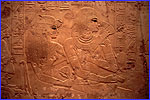
Though left unfinished, this is the finest carved tomb in the Valley of the
Nobles. Ramose was a governor of Thebes and vizier of Egypt under both
Amenophis III and Amenophis IV (better known as Akhenaten). It is significant
not only for the quality of its paintings and low reliefs, but because the wall
carvings show a transition between the formal style under Amenophis III and the
new, looser style under Akhenaten. (Akhenaten was the "rebel" pharaoh who
established the world's first monotheistic religion, based on a belief in the
Aten, or sun disk.)
|  Notice the meticulous carving of hair
in this detail from the east wall of Ramose's tomb.
Notice the meticulous carving of hair
in this detail from the east wall of Ramose's tomb.
|
This image opens with a view from the southeast corner, looking northwest into
the Main Hall. Originally it was meant to hold 32 stone pillars, many of which
are now missing. You can see entrance steps leading down into the tomb mid-way
along the right wall.
 Women and girls mourn the death of Ramose in this painting on the south
wall.
Women and girls mourn the death of Ramose in this painting on the south
wall.
|
|
As you turn to the right, notice the exquisite reliefs along the right (east)
wall. These show Ramose's family, friends, and others bearing offerings for the
deceased. (Zoom in for a closer look at the hieroglyphs.) High on the south
wall are well-executed paintings of Ramose's funeral procession.
In your examination of this room, look for a gaping hole behind a broken
column. This leads steeply down a series of dusty stone staircases to the
unfinished burial chamber, which rests perhaps 100 feet below the Inner Hall.
|
 |




 Notice the meticulous carving of hair
in this detail from the east wall of Ramose's tomb.
Notice the meticulous carving of hair
in this detail from the east wall of Ramose's tomb.
 Women and girls mourn the death of Ramose in this painting on the south
wall.
Women and girls mourn the death of Ramose in this painting on the south
wall.